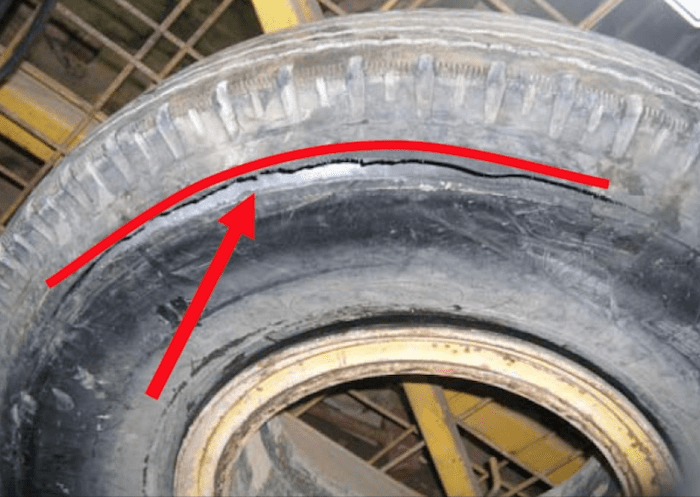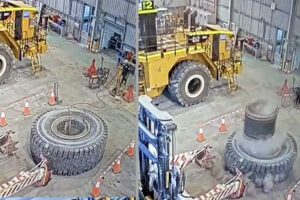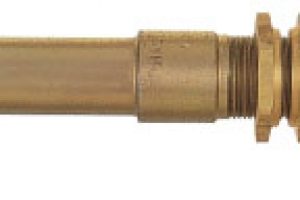A BAD LINK ON OUR EMAIL CAMPAIGN MAY HAVE BROUGHT YOU TO THIS PAGE….IF YOU ARE LOOKING FOR OUR STORY ON THE DIGGER AT CAVAL RIDGE….CLICK HERE
Wayne MacDonald was a 53 year old, experienced, truck driver who died in 2010 at a Queensland mine when a tyre he was fitting to his truck exploded from ‘zipper failure.’
Wayne’s wife, Pam, said at the time her husband was “let down by his employers”. “Wayne was hard-working, nothing was too much trouble, he loved life and he was my life. The pain and hurt I’ve to deal with and (am) still dealing with cannot be put into words and I just hope it doesn’t take another fatality for changes to continue.”
What happened?
The following is an excerpt from the Coronial Inquest (Links to the Inquiry Documents are attached below).
Wayne worked at Foxleigh coal mine in the Bowen Basin region of Central Queensland driving heavy trucks which hauled coal. Following transporting nine loads of coal, he called his base and advised that one of his trailers had sustained a flat tyre. His supervisor advised him to drive to a location called “The Mailbox”, where the tyre could be changed.
At 5.15 am on the 18th December 2010 he drove his truck to the appropriate facility at the mine site to change the failed tyre.
There he used a short handled, manual jack, placed under the appropriate axle of the trailer, to lift the trailer and change the tyre. He had provided to him by a work colleague what was thought to be a suitable replacement tyre from those tyres made available. The tyre that was chosen, from a number that were available, was marked in chalk with the notation “SLOW LEAK/OK”.
The truck tyre was then inflated to what was considered to be the operational tyre pressure. Mr MacDonald had completed the tyre changing task without incident until he was lowering the trailer to the ground using the jack which required him to place himself between two pairs of wheels on the four axle (double bogie) trailer.
As the replacement tyre came into contact with the ground it catastrophically failed, suffering what was later described as a ‘zipper failure’.
Wayne, who was then positioned, lying on the ground, between the trailer’s tyres, was hit by a percussive shockwave of air causing him fatal injuries. He died at the scene.
The Coroner said clearly tyre blast, in whatever circumstances, in the mining industry is not entirely unheard of, and should not be considered as a ‘one in a billion event’, as described by one person who gave evidence. Certain industry practices to minimise the risks associated with tyre blast need to change.
At the inquest a great deal of information was provided by investigators, the owners of the mine, the tyre suppliers, the contractor trucking company, and the union representing the coal industry employees. This broad cross-section of interests in the coal mining industry provided a significant opportunity for the interests of all parties to be put forward.
“Ultimately, after hearing the evidence, it was clear that how Mr MacDonald died was due to a tyre failure, known as a zipper failure, which failure caused a catastrophic percussive shockwave of air to strike him, whilst he lay in the confined space between two sets of wheels on the trailer as he undertook the task of replacing a damaged tyre.
Similarly, the evidence provided at the inquest was clear, and there was no contest or dispute, that what caused Mr MacDonald to die were multiple injuries, due to, or as a consequence of, tyre explosion as described by the forensic pathologist.
It was accepted by all parties that the ‘failure’ of the tyre was a zipper failure, which is said to occur as a result of ply cord failure in the steel radial chords, or plys, in the tyre wall. Mr Southwell, the independent tyre expert who actually examined the particular tyre, found that this was the reason that the tyre failed on 18 December 2010.
What preceding events led to the tyre failing in this way was far more contentious between the parties, and this occupied a significant amount of exploration at the inquest, and in submissions.
How can Zipper failure occur?
Put very broadly zipper failure, on the evidence of the experts, can occur through two main events.
Firstly, from the operation of the tyre well outside its design load/speed/inflation pressure limits, leading to a weakening in the steel cords of the tyre’s plys, or, secondly, through any accidental sidewall damage which has weakened the steel cords of the tyre. An example of this was damage to a tyre in its handling, prior to any use, through being impacted by forklift tines, causing sidewall damage, for example a cut.
Mr Southwell who conducted a thorough physical examination of the tyre found there was no evidence that the sidewall had been damaged through accidental damage, such as its handling prior to use. The experts all agreed that the likely reason for the zipper failure which occurred in Mr MacDonald’s case was due to the tyre being operated for a period of time outside its design parameters.
The evidence presented showed that zipper failure can occur without any noticeable warning signs, and the only possible sign of an impending zipper failure may be a slight metallic pinging sound as steel cords break as the tyre is being inflated. It was noted that at the mine site, which I understood was industry practise, that tyres were inflated in an appropriate steel cage so that if zipper failure occurred during inflation potential injury to persons was minimised.
The zipper failure in Mr MacDonald’s case occurred after the tyre had been successfully inflated to what was believed to be the operating pressure. The tyre was then safely handled as it was changed. The evidence suggested that as the tyre came under load, at the time it came into contact with the ground, it then catastrophically failed. Put at its simplest, Mr McDonald was injured because of the position he was then in, close to the zipper failure, and in an enclosed space.
Can any steps be taken to minimise this risk from tyre burst?
Certainly there can be steps taken. Leaving aside the issue of an Australian Standard in respect of these larger diameter wheels and tyres, the minimisation of risk can occur through the tyre initially being pressured tested, for a short period of time above their correct operating pressure by being overinflated by approximately 20% whilst in the steel tyre inflation cage.
Evidence was given at the inquest of the practice adopted where tyres were tested by inflating them to approximately 20% above their operating pressure, and leaving the tyre inflated for approximately 20 minutes, before deflating them to their operational pressure and then putting the tyre into service.
It was considered that this simple step lessened the risk of tyre failure because the tyre had already demonstrated, in the controlled environment of the steel inflation cage, that it could satisfactorily accept a higher pressure, even if that high pressure had only occurred in a static environment, rather than in a dynamic environment of its actual use.
Coroners Recommendations (Summary)
This incident does provide the opportunity to recommend important improvements aimed at reducing the risk to workers in similar operations.
In consideration of the evidence of this case, and for the reasons I have set out above, I recommend the following:-.
1) That management of mine sites, and their engaged contractors, review all tyre management practices to ensure that tyres on their mine sites are being operated within their specific design parameters applicable for their use. This review needs to occur within three months, and then annually the mine site needs to ensure that compliance is being maintained.
2) That any jack used by an operator has a handle of sufficient length to allow the operator to safely use the jack without the operator being in, or under, the truck or trailer, or within close proximity of the vehicle’s tyres whilst jacking occurs.
3) That the industry investigate, and implement within two years, remote, or wireless, tyre pressure sensing equipment to allow operators to monitor tyre pressures from within the cabin of the truck;
4) That until remote or wireless tyre pressure sensing equipment is introduced for these mine site tyres that the practice of tyre tapping should not be continued, and that accurate, calibrated, pressure gauge should be used to check correct tyre inflation whenever operational requirements dictate that pressures are to be checked;
5) That an Australian Standard for up to 24 inch diameter truck tyres be investigated, created, and, if considered appropriate, implemented into law by regulation within a period of two years, and if no Australian Standard is created within two years then a Recognised Standard under Part 5 of the Coal Mining Safety and Health Act 1999 be implemented within one year;
6) That whenever a tyre supplier grants a dispensation from the designed operating parameters of a tyre, that the tyre supplier provide, and receive written acknowledgement of from the customer, an appropriate and formal information package which clearly specifies the approved conditions of operation of that dispensation;
7) That whenever a tyre supplier grants a dispensation which a mine site operator uses, that the equipments owners and operators incorporate into their written training and operating procedures the specific details of those dispensations;
8) That whenever a tyre manufacturer grants a dispensation from the designed operating parameters of a tyre, that the variations be permanently embossed (alternatively termed ‘tyre stamping’) on the sidewall of the tyre, and that the embossing be completed in a method which is not readily removable, and remains legible, throughout the tyre’s serviceable life;
9) That every tyre, whether new or repaired, undergo integrity testing by its inflation in a suitable tyre inflation cage, to a pressure of 120% of the tyre’s recommended minimum cold operational inflation pressure, and then left for 20 minutes to test its integrity, before its pressure is then reduced to its recommended minimum operating pressure before the tyre is then fitted for use.
You can Read the Full Coronial Inquest Document Here
The Queensland Standard that followed this inquest Recognised standard 13 Tyre, wheel and rim management
Read More Mining Safety News














Add Comment